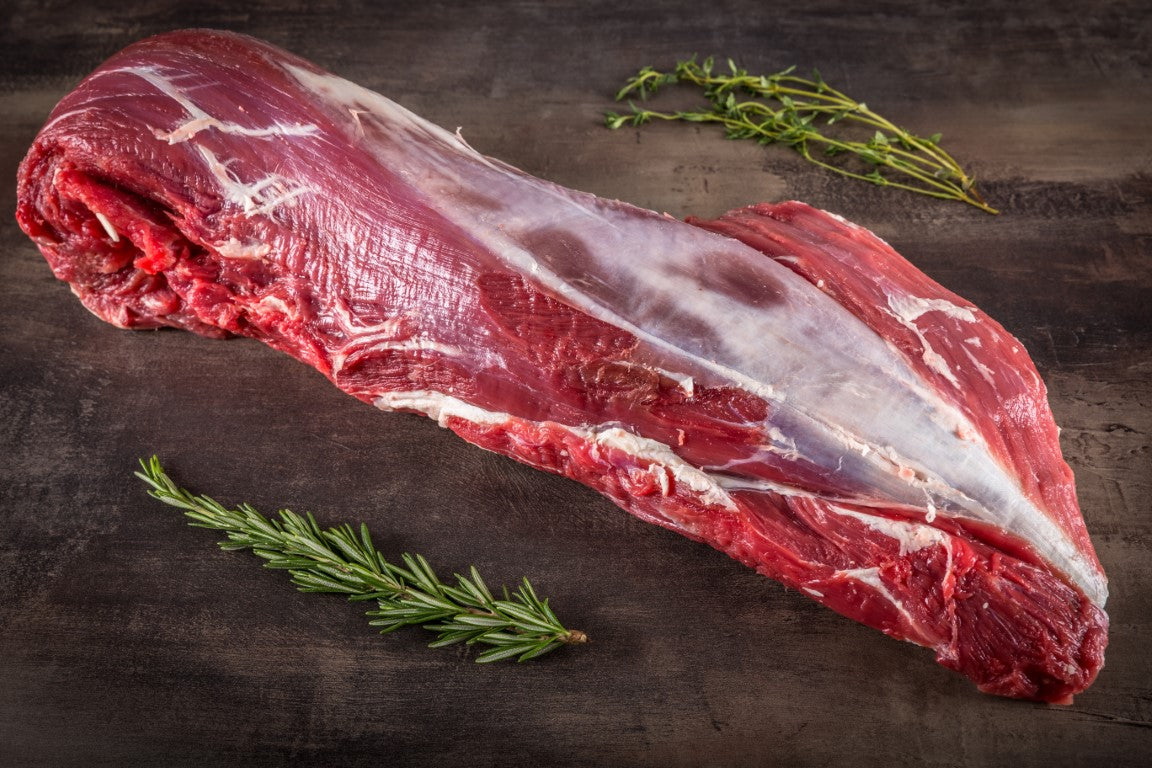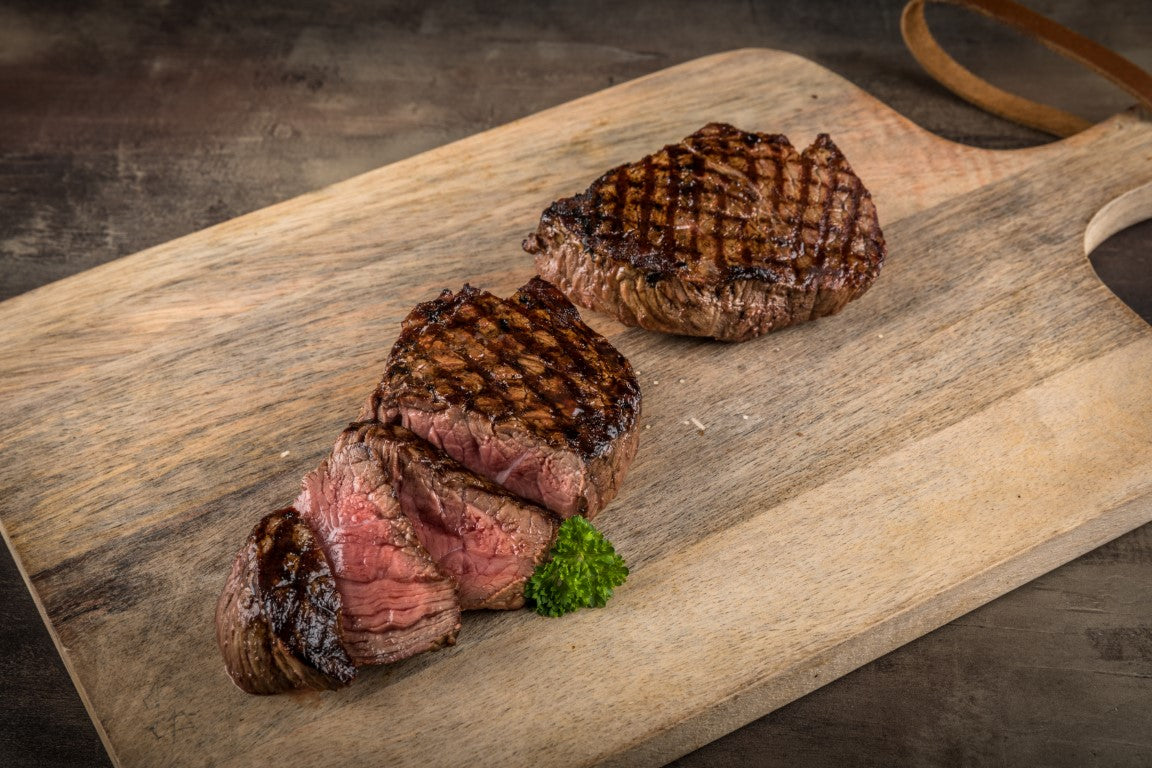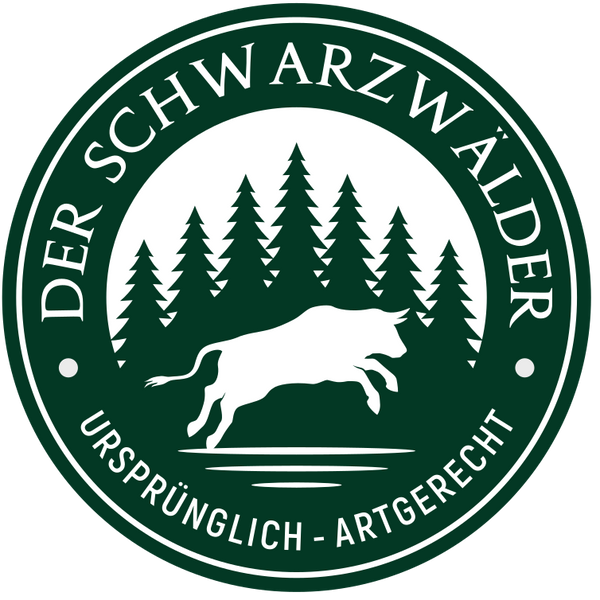Black Forest beef fillet in one piece
The beef fillet in one piece is ideal for Filet Wellington, for example, but also as a beef fillet roast or for portioning yourself.
The beef fillet is undoubtedly one of the best cuts of beef steak. It requires little processing, making it extremely tender. The meat is particularly lean and short-fibered .
To ensure the highest quality, we only ship beef fillets that have been dry-aged for at least four weeks. This aging process imparts a slightly nutty flavor and makes the fillet extremely tender.
Through our own rearing and slaughtering, we influence species-appropriate animal husbandry and thus the quality of the meat at all points.
Of course, you will receive the beef fillet from us trimmed and ready to cook, if necessary including the fillet head and tip (depending on weight).
The beef fillet is undoubtedly one of the best cuts of beef steak. It requires little processing, making it extremely tender. The meat is particularly lean and short-fibered .
To ensure the highest quality, we only ship beef fillets that have been dry-aged for at least four weeks. This aging process imparts a slightly nutty flavor and makes the fillet extremely tender.
Through our own rearing and slaughtering, we influence species-appropriate animal husbandry and thus the quality of the meat at all points.
Of course, you will receive the beef fillet from us trimmed and ready to cook, if necessary including the fillet head and tip (depending on weight).

The properties of the beef fillet
The beef fillet, or sirloin , is one of the least used muscles. It runs parallel to the inside of the spine in the hindquarters. The thin part of the fillet, the tip, points toward the head of the cow, while the thick part, the fillet head, points toward the rear. The limited movement of this muscle strand makes the fillet so tender. A cow has two sirloin muscles. With a weight of 3-5 kg, it accounts for approximately 1.5% of the total meat weight, making it the most expensive cut of beef.
By the way, the fillet is also called lung roast in Austria.
By the way, the fillet is also called lung roast in Austria.
Raising our cattle
When you buy beef fillet from us, you'll always receive meat from our own herd and the herds of our partners. All farms are located near our butcher shop in the Black Forest.
The animals are raised exclusively with the farm’s own feed.
Our motto is: If the animal is well, the human is well. Based on this, we create high-quality products of outstanding quality.
Our short transport routes protect the livestock and the environment. We transport the animals a maximum of 50 km from the farm to our butcher shop. A gentle and stress-free slaughter process directly on our premises is an important component for the quality of our steaks.
The animals are raised exclusively with the farm’s own feed.
Our motto is: If the animal is well, the human is well. Based on this, we create high-quality products of outstanding quality.
Our short transport routes protect the livestock and the environment. We transport the animals a maximum of 50 km from the farm to our butcher shop. A gentle and stress-free slaughter process directly on our premises is an important component for the quality of our steaks.
Dry-aged beef – quite normal for us
What's trendy today is tradition for us. Aging meat on the bone is as old as the butcher's trade. We've never abandoned this tradition and only dry-age our beef steaks. Due to the loss of liquid, the beef loses up to 50% of its weight, but remains juicy after cooking. This aging method prevents the meat from becoming too acidic and enhances the natural, robust flavor.
Classic preparation methods for beef fillet in one piece
There are several traditional ways to prepare a whole beef fillet:
- Carpaccio - The beef fillet is lightly frozen and thinly sliced onto platters. The slices are seasoned with salt, pepper, balsamic vinegar, and olive oil. Freshly grated Parmesan cheese is added to finish.
- Fillet roast - The whole fillet is seasoned and seared. It's then placed in the oven to finish cooking to reach the desired internal temperature .
- Filet Wellington - The fillet is seared, seasoned, and then wrapped in puff pastry with duxelles (mushroom stuffing). Cooked at medium heat, the pastry remains crispy and the meat remains juicy.
-
Fillet steaks - Various steak cuts from the fillet:
- Chateaubriand – Cut from the fillet head, weighing 400-600g. Traditionally served medium-rare for two people.
- Tournedos - Cut from the middle, approximately 100-180g. Wrapped in bacon and briefly fried.
- Medallions/Mignons – From the tip, approx. 60g and served medium-rare.
- Beef Stroganoff – Cut into small cubes or strips, sautéed in butter and served with onions and sour cream sauce.
Measuring the core temperature of a beef fillet
To cook meat to perfection, we recommend using a digital probe thermometer. Insert the probe into the center of the meat to measure the correct internal temperature .
Tip: Hold your finger where you want the probe to penetrate the meat and insert the thermometer to that depth.
Tip: Hold your finger where you want the probe to penetrate the meat and insert the thermometer to that depth.
Core temperature of beef fillet in one piece
The core temperature is a matter of personal preference. The table shows recommended cooking times; the temperature marked in bold is our recommendation for whole beef fillet :
* Our core temperature recommendation for beef fillet in one piece: 56 °C
| Designation | Description | core temperature |
|---|---|---|
| Blue | Roasted on the outside, cool and raw on the inside | 42 °C |
| Rare / Bloody | Very reddish in the core | 48-52 °C |
| Medium-Rare | Slight discoloration, still strongly reddish | 52-56 °C |
| medium | Clearly visible color change, still red tone | 56-60 °C |
| Well Done / Through | Almost completely recolored, no red tone | 60-64 °C |






 Aus eigenem & Partner Viehbestand
Aus eigenem & Partner Viehbestand Dienstags und Donnerstags Versandtag
Dienstags und Donnerstags Versandtag

